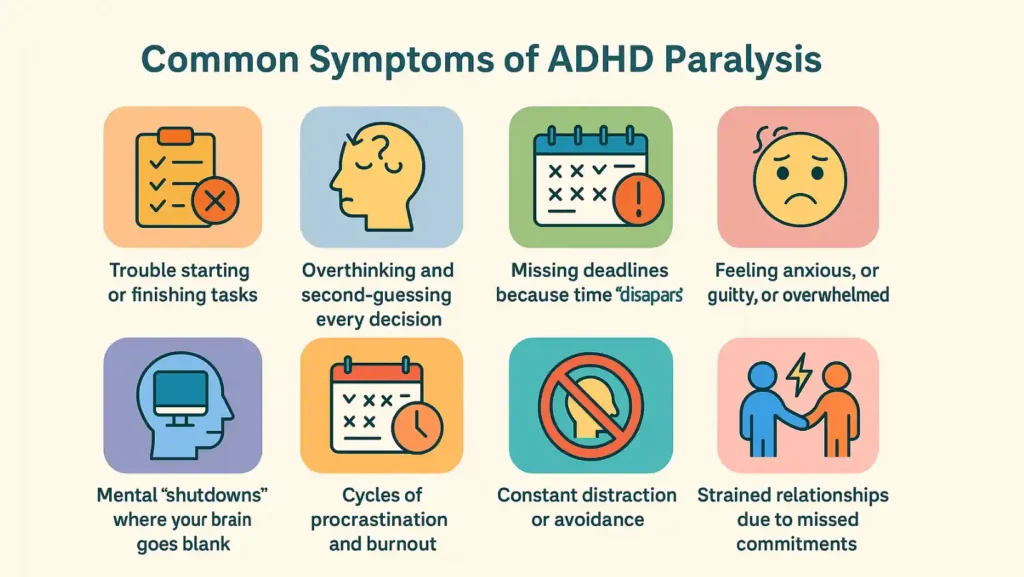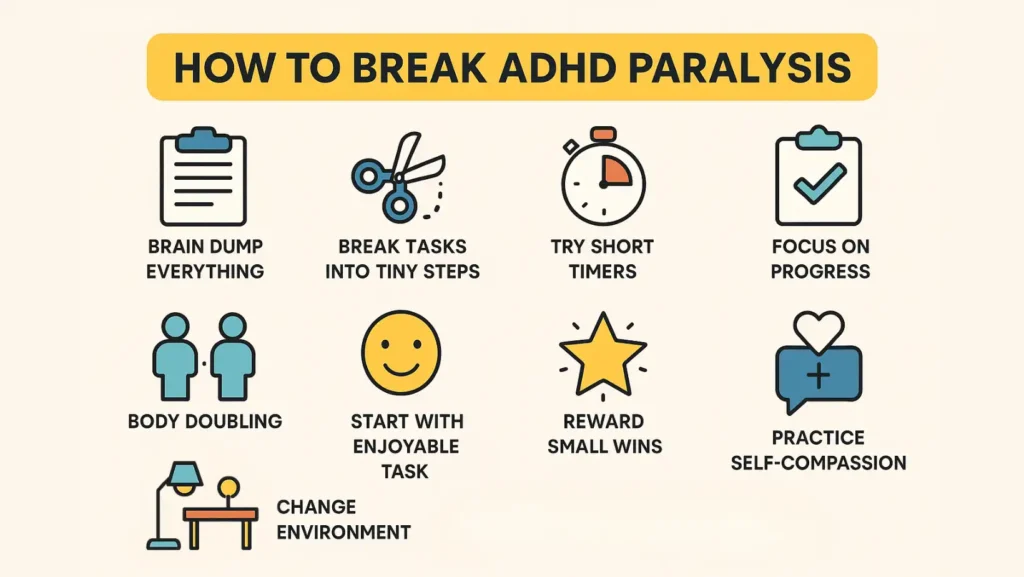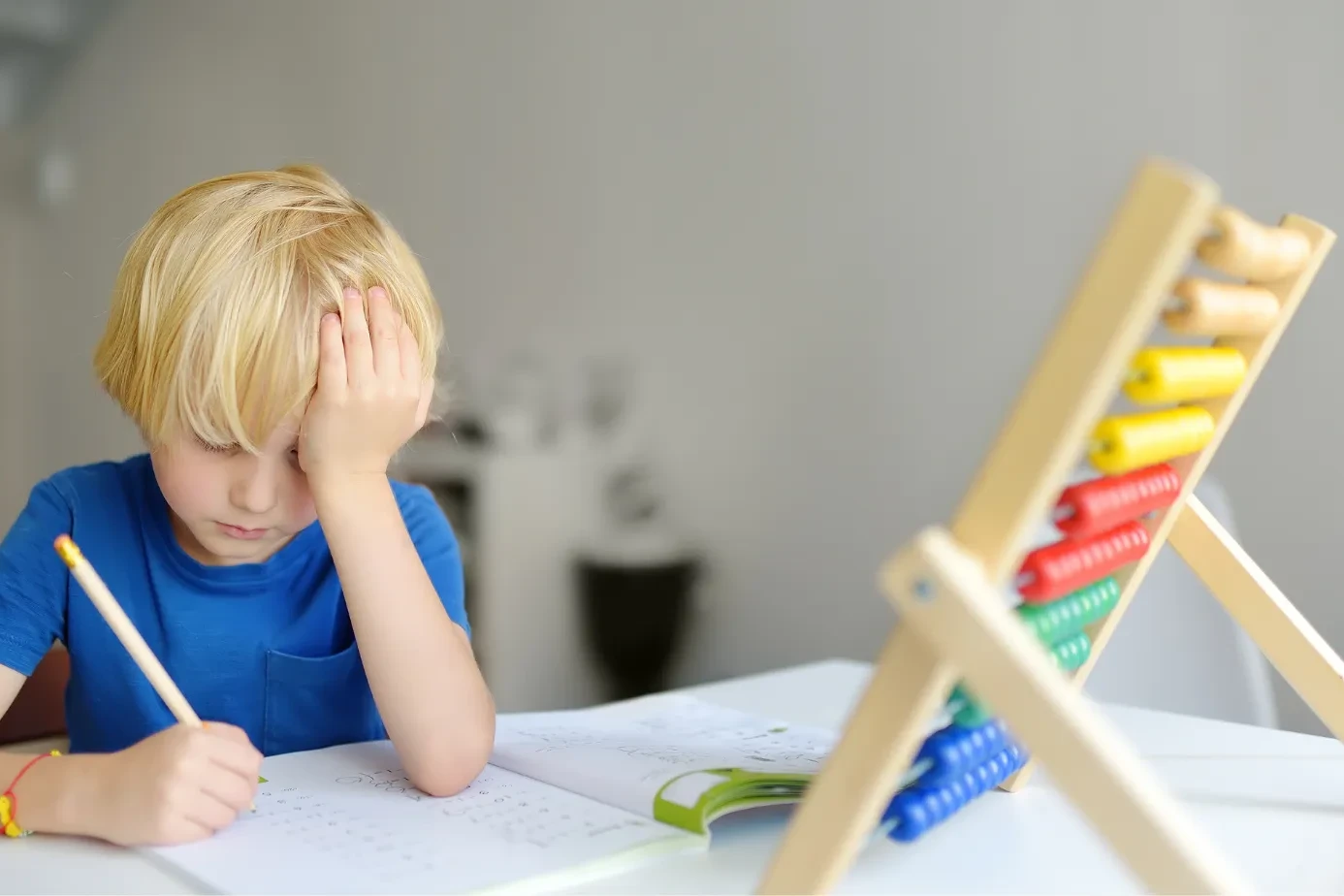ADHD paralysis is a state where your brain feels “stuck,” even when you know exactly what to do. You want to start a task, but can’t. It’s not about laziness or bad habits; it’s about how ADHD affects your brain’s ability to start, switch, or complete tasks.
This mental “freeze” often appears when you’re overwhelmed, anxious, or facing decisions that feel too big. It’s one of the most frustrating parts of living with ADHD, yet it’s also one of the least talked about.
Understanding why it happens and how to break it can help you take control again.
Table of Contents
ToggleADHD Paralysis Explained
ADHD paralysis happens when your brain’s planning and reward systems stop working together. It’s common in both kids and adults with ADHD. The brain gets overloaded, can’t sort what to do first, and locks up. This “executive freeze” makes even simple tasks feel impossible.
What ADHD Paralysis Means (Definition)
The ADHD paralysis definition refers to a neurological block that prevents you from starting or completing tasks, even ones you want to do. It often comes with racing thoughts, anxiety, or emotional overload. You may sit, think, and do nothing, not because you don’t care, but because your brain is short-circuiting under pressure.
Also Known as Task Paralysis or Executive Freeze
You might hear it called “task paralysis” or “executive dysfunction freeze.” They describe the same thing: the brain’s executive function (the part responsible for planning, organization, and action) gets jammed and stops sending clear “go” signals.
How It Differs From Procrastination or Laziness
Procrastination is a conscious choice to delay something. ADHD paralysis, on the other hand, isn’t a choice; it’s an inability to act. Laziness means not wanting to do something. ADHD paralysis means you do want to do it, but can’t make your brain move. It’s a biological stall, not a motivational one.
What Happens in the ADHD Brain
Your prefrontal cortex (the part that plans, focuses, and makes decisions) depends on dopamine (a brain chemical linked to motivation and reward). When dopamine is low, that system slows down. The brain no longer sees tasks as “urgent” or “rewarding,” so it resists starting. That’s why boring or complex tasks trigger paralysis, while exciting ones feel easier.
Role of Dopamine and Executive Function
Low dopamine makes it harder to prioritize, start, or stick with tasks. Executive function organizes thoughts and time. When both are off-balance, your brain gets stuck between “wanting to act” and “unable to act.” This is where ADHD paralysis symptoms often show up.
Types of ADHD Paralysis
1. Mental Paralysis
Your brain feels foggy or overloaded. You can’t think clearly or decide what to do first. Thoughts keep looping without action.
2. Task Paralysis
You stare at a simple to-do, like answering an email or cleaning your desk, but can’t start. Even when you know it’s quick, your body won’t move.
3. Choice Paralysis
Too many choices can paralyze you. You can’t decide which option is “right,” so you pick none.
How These Types Overlap in Daily Life
You might face all three at once. You can’t choose (choice paralysis), so your brain fogs up (mental paralysis), and then you stop acting altogether (task paralysis).
Common Symptoms of ADHD Paralysis

- Trouble starting or finishing tasks
- Overthinking and second-guessing every decision
- Missing deadlines because time “disappears”
- Feeling anxious, guilty, or overwhelmed
- Mental “shutdowns” where your brain goes blank
- Cycles of procrastination and burnout
- Constant distraction or avoidance
- Strained relationships due to missed commitments
Each of these ADHD paralysis symptoms results from your brain’s stress response, combining with executive dysfunction.
Main Causes of ADHD Paralysis
| Cause | Description |
| Executive Dysfunction | Breakdown in planning and follow-through. Your brain can’t organize tasks into action steps. |
| Low Dopamine | The brain’s reward system is underactive. Tasks feel pointless or dull. |
| Perfectionism | Fear of mistakes stops you before you begin. |
| Task Overwhelm | Too many tasks cause panic and freeze. |
| Emotional Dysregulation | Strong feelings block logical planning. |
| Cognitive Overload | Too many thoughts at once cause shutdown. |
| Negative Self-Talk | Guilt and shame weaken motivation. |
| Rejection Sensitivity (RSD) | Fear of criticism prevents you from acting. |
These ADHD paralysis causes combine to create mental “traffic jams” that block productivity.
ADHD Paralysis vs. Procrastination
Why ADHD Paralysis Isn’t Just Procrastination
Procrastination happens when you choose to delay. ADHD paralysis happens when you can’t move, even if you want to. It’s not a matter of discipline; it’s neurological.
Neurological vs. Motivation-Based Delay
Paralysis comes from dopamine imbalance and executive dysfunction. Procrastination is emotion—based on fear, boredom, or low interest.
Why You “Want to Start” but Can’t
The ADHD brain can’t link small tasks to big rewards. It feels no dopamine “spark,” so it doesn’t start. Once the task feels urgent or fun, the brain finally acts.
How to Identify Your Triggers
Notice what tasks cause paralysis: are they boring, complex, or emotional? Knowing triggers helps build personalized ADHD paralysis strategies to overcome.
ADHD Paralysis in Adults and Children
How It Manifests by Age
Children often show it through zoning out, avoiding homework, or daydreaming. Adults experience it as missed deadlines, clutter, and chronic lateness.
In Children
Kids may freeze when given too many instructions or a large assignment. They might seem defiant, but it’s a stress response, not bad behavior.
In Adults
Adults often feel ashamed of unfinished tasks or messes. They overpromise, then crash into paralysis when stress peaks.
Emotional Impact
Both kids and adults feel guilt after freezing. This emotional spiral fuels future paralysis, creating a self-defeating cycle.
How to Break ADHD Paralysis

Breaking ADHD paralysis takes structure, emotion control, and brain-friendly tools.
- Brain Dump Everything: Write every task swirling in your mind. Getting it out clears mental space.
- Break Tasks into Tiny Steps: Instead of “clean the kitchen,” start with “pick up one plate.” Tiny steps lower resistance.
- Focus on Progress, Not Perfection: Perfectionism is paralysis in disguise. Aim for done, not flawless.
- Use Accountability or Body Doubling: Work beside someone or on a live video call. Their presence keeps you grounded.
- Try Short Timers: Set a 10-minute timer. The brain can handle short bursts better than long stretches.
- Reward Small Wins: Dopamine loves rewards. Treat yourself for progress, not just completion.
- Change Your Environment: Remove clutter and distractions. A fresh setup resets your focus.
- Start With Enjoyable Tasks: Momentum fuels motivation. Easy wins warm up your brain.
- Practice Self-Compassion: Harsh self-talk drains focus. Kindness resets your nervous system.
- Seek Therapy or Medication if It’s Chronic: Professional help can balance dopamine and rebuild habits.
These steps summarize how to break ADHD paralysis effectively, one micro-step at a time.
Therapy and Medical Support
- Medication: ADHD meds boost dopamine, improving focus and motivation.
- Cognitive Behavioral Therapy (CBT): Helps you manage avoidance and self-blame.
- ADHD Coaching: Teaches structure, planning, and accountability.
- Mindfulness & Grounding: Calm your mind to lower emotional flooding.
- Journaling: Tracks triggers and small victories.
- Healthy Lifestyle: Sleep, nutrition, and movement sharpen focus naturally.
Emotional Triggers That Worsen Paralysis
- Fear of Failure: Stops you before you start.
- Negative Self-Talk: Lowers confidence and focus.
- Overcommitment: Spreads energy too thin.
- Rejection Sensitivity: Fear of judgment fuels avoidance.
- Therapy’s Role: Trains your brain to respond differently to stress triggers.
ADHD Paralysis Strategies That Work
- Build a daily routine so you act without overthinking.
- Match tasks to your energy levels; do hard things when alert.
- Use visual tools like sticky notes or whiteboards.
- Try digital ADHD apps that simplify tasks.
- Join accountability groups for support and follow-through.
These are proven ADHD paralysis strategies to overcome long-term paralysis patterns.
FAQ
What are the early signs of ADHD paralysis?
You freeze before starting tasks. You overthink and lose track of time. You feel overwhelmed. You avoid work and feel guilty. You may stall on small chores.
How Can I Stop ADHD Paralysis Quickly?
Use a five-minute timer. Pick one tiny step. Ask someone to sit with you or call a friend. Short bursts break the freeze.
How Long Does ADHD Paralysis Last?
It lasts from minutes to hours. Patterns can repeat. When triggers return, paralysis can return. Work and tools cut its length.
How can therapy or coaching help with ADHD paralysis?
Therapy teaches coping and reframing skills. Coaching trains tasks into steps. Both give structure and reduce the shame that causes freezes.
Is ADHD paralysis linked to depression or anxiety?
Yes. Anxiety and depression worsen paralysis. They lower energy and make starting tasks harder. Treating mood helps reduce paralysis.
Does ADHD paralysis go away over time?
It can improve with treatment, structure, and practice. It rarely disappears alone. Use skills and supports to reduce its hold.
About The Author

This article is medically reviewed by Dr. Chandril Chugh, Board-Certified Neurologist, providing expert insights and reliable health information.
Dr. Chandril Chugh is a U.S.-trained neurologist with over a decade of experience. Known for his compassionate care, he specializes in treating neurological conditions such as migraines, epilepsy, and Parkinson’s disease. Dr. Chugh is highly regarded for his patient-centered approach and dedication to providing personalized care.
→ Book a consultation to discover which remedies suit your needs best.




